The argument in the West about India’s “unreliability” is episodic and periodic. The accusation, for instance, is as old as the Quad itself even though India is the only member to have locked horns with China, stare back and thwart its policy of territorial aggrandizement, and despite the fact that that Quad 1.0 was aborted due to Australia’s betrayal.
Still, the collective West seems to suffer from an intrinsic and chronic insecurity when it comes to India’s China policy. It is interesting to observe a return of this debate as India and China announced that they have entered into an understanding to disengage from two remaining friction points at Eastern Ladakh and restore patrolling rights just ahead of the BRICS Summit. The summit, held in Kazan, Russia, also saw prime minister Narendra Modi meeting Chinese president Xi Jinping in a formal bilateral setup for the first time in five years, signifying a melting of the ice in ties.
In a recent column, I have argued that the development is tactical, not a strategic reset and while significant, it should not be over-interpreted.
While the United States, whose Indo-Pacific strategy is incumbent on using India as a bulwark and a democratic counterweight to China, has responded after a few days of radio silence with a pedestrian statement “welcoming any reduction of tensions along the border”, western media has been more forthcoming, accusing India of ‘betrayal’, calling into question America’s Indo-Pacific strategy and blaming Xi for “undercutting” the West by “negotiating a truce with India.”
Business Insider, an American outlet published from New York City, observes that Washington “has sought to recruit India to help it contain China’s growing regional aggression alongside other members of the Quad”, and quotes analysts who say that “this is a setback for the US Indo-Pacific outlook” and a blow to Washington’s attempts to attempts to “include India in a deeper security alliance.” Some analysts interpret India’s membership of both Quad and BRICS, a non-western platform as “contradictory”, aimed at “balancing its interests”.
Voice of America, for instance, quotes a Bucknell University professor, as saying that “the thaw in India-China relations is a boon to both countries. This is particularly significant for China because India may now be less inclined to confront Beijing as part of Quad.”
Impact Shorts
View AllThe New York Times is apprehensive that “China wants to use the grouping to weaken the dominance of the United States and burnish its credentials as a leader of the so-called Global South…”
Even the ho-hum statement issued by the US Department of State could be a reflection of the Biden administration’s disappointment at the ‘détente’ between India and China. Some analysts feel that if not in public, the US must be privately expressing its discontent.
All of this leads us to ponder over the nature of the debate and its motivations. It can’t be a practical expectation that a country which shares a 4000 km border with China – ruled by a dictatorial leader of a one-party authoritarian system that believes in territorial expansion to get over its ‘century of humiliation – will not try to achieve stability, peace and tranquility at the border to get ahead with the serious business of fulfilling the hopes and aspirations of a billion Indian citizens.
The surprising reaction in western media – The Economist calls “resolving the border row” when clearly it is not – borders on panic. As if the entire China containment strategy of the US-led West will collapse now that India has kissed and made up with China. These assumptions are erroneous and need to be challenged.
The apparent panic that has set in – Canada’s state-affiliated media came out with an evocative headline ‘India makes it clear it’s not interested in a Western alliance’ – over just one formal meeting between Modi and Xi in five years reveals the West’s insecurity.
This insecurity is a pointer to the fact that that the West cannot think beyond camp politics, and it is outside the realm of its theoretical and conceptual framework that a state can choose to remain non-aligned.
For all the multifaceted and diversified partnership with India and rhetorical commitment to the relationship, the US and its transatlantic allies still interprets India’s strategic autonomy not as the function of choice, but the eventuality of compulsion.
In this reading, India practices an autonomous, unaligned (or multi-aligned) foreign policy, but that autonomy is only a feint to evade commitment and responsibility in a partnership while seeking all the benefits.
This may explain why India is regularly referred to in media and policy parlance as a ‘swing state’ that seeks to profit from promiscuity. This very Catholic framing fundamentally misdiagnoses India’s function of choice – that it chooses strategic autonomy because it wants to remain autonomous, retain policy space and avoid being dragged into camps.
This is why India’s effort to mend ties with China has immediately been interpreted as some sort of a betrayal by the West, that not only fails to understand the tenets of India’s foreign policy but also misconstrues New Delhi’s position in the Indo-Pacific strategy. India has and will stand up to China to protect its interests and safeguard its territory, but it shall not be a willing pawn in great power competition.
CBC suggests in its report that prime minister Modi visited Moscow in July and called upon the Russian president at his residence as a signal to the US not to squeeze India too hard on the Gurpatwant Pannun controversy. Such an analytical leap falls flat because it fundamentally misunderstands the roots and dynamics of India-Russia ties.
Sadanand Dhume observes in the Wall Street Journal that “India is in the midst of a partial rapprochement with China, but anyone who thinks New Delhi can afford to alienate the West is delusional.” The truth is that India does not seek to alienate the West. It is the West that is seeking to keep India under pressure using the festering Khalistan issue as a leverage (‘Some Khalistani extremists are deep assets of CSIS, says recalled envoy to Canada Sanjay Verma’.
It is the West that believes it has the upper hand in the relationship and is seeking to modify India’s behaviour without even a passing acknowledgement of India’s core concerns.
India’s disengagement with China may not be strategic, but western diffidence at the development points to the fact that West’s partnership comes with strings attached.


)
)
)
)
)
)
)
)
)



